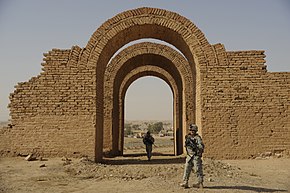Assur
| Aššur ܐܫܘܪ آشور |
|

American soldiers on guard at the ruins of Ashur in 2008
|
|
| Location | Saladin Governorate, Iraq |
|---|---|
| Region | Mesopotamia |
| Coordinates | 35°27′24″N 43°15′45″E / 35.45667°N 43.26250°ECoordinates: 35°27′24″N 43°15′45″E / 35.45667°N 43.26250°E |
| Type | Settlement |
| History | |
| Founded | Approximately 2500 BC |
| Abandoned | 14th century AD |
| Periods | Early Bronze Age to ? |
| Site notes | |
| Public access | Inaccessible (in a war zone) |
| Official name | Ashur (Qal'at Sherqat) |
| Type | Cultural |
| Criteria | iii, iv |
| Designated | 2003 (27th session) |
| Reference no. | 1130 |
| Region | Arab States |
| Endangered | 2003–present |
Aššur (Akkadian; Syriac: ܐܫܘܪ 'Āshūr; Persian: آشور: Āshūr; Hebrew: אַשּׁוּר Aššûr, Arabic: اشور: Āshūr, Kurdish Asûr), also known as Ashur and Qal'at Sherqat, was an Assyrian city, capital of the Old Assyrian Empire (2025–1750 BC), Middle Assyrian Empire (1365–1050 BC), and for a time, the Neo-Assyrian Empire (911–605 BC). The remains of the city are situated on the western bank of the Tigris River, north of the confluence with the tributary Little Zab River, in modern-day Iraq, more precisely in the Al-Shirqat District in the Saladin Governorate.
...
Wikipedia

